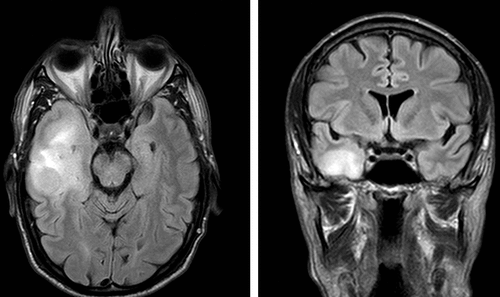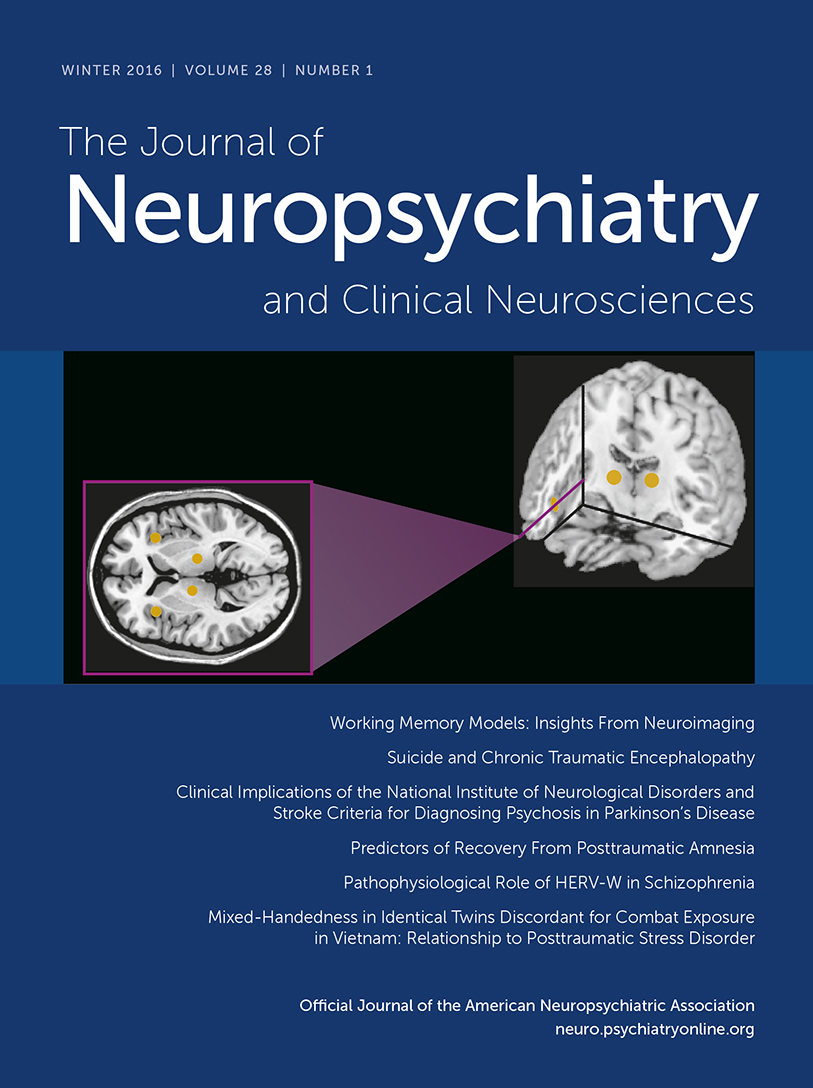Transient Prosopagnosia With Right Temporal Astrocytoma
To the Editor: Prosopagnosia is a visual agnosia featuring impaired ability to recognize familiar faces and learn new ones, with preserved ability to identify people by voice or nonfacial visual characteristics.1 Structures subserving facial recognition include the inferior occipital and fusiform gyri, the posterior superior temporal sulcus, the anterior temporal cortex, and the limbic system.2,3 Lesions producing prosopagnosia are often bilateral, but right unilateral lesions have also been reported, and patients may also have visual field defects, central achromatopsia, and topographical disorientation. Prosopagnosia, either acquired1 or congenital,4 is usually permanent, but transient prosopagnosia is rare.
The regions subserving face recognition are also involved in some forms of synesthesia, the commingling of the senses arising when stimulation in one sensory modality triggers a perceptual experience in another.5 For most individuals with synesthesia, the trait is congenital and lifelong, but rare acquired cases have been described.5 Proposed mechanisms of congenital synesthesia include failure to prune synaptic connections, or the formation of extra synaptic contacts, during brain development, and deficient inhibition of cross-modal sensory associations.5
Case Report
A 59-year old right-handed man abruptly lost the ability to recognize faces for 1 week. The patient could not recognize his wife’s face, the faces of friends, or his own face in the mirror, but he could immediately identify these individuals by their voices and clothing, and he retained otherwise intact memories of each person. During that same week, he also reported two brief episodes of perceiving inanimate objects to have personality and emotion, the first with wadded pieces of paper on the floor of his studio, and the second as he was riding in a car and saw two all-terrain vehicles on a passing trailer. Other symptoms during this time were recurring visual hallucinations, which he recognized as unreal, of bird silhouettes and painted road surface markings superimposed on the sky, buildings, and hillsides, as well as two episodes of déjà vu followed by brief confusion. The patient otherwise felt cognitively normal, and he reported no symptoms concerning language, attention, memory, comportment, color vision, or spatial orientation. His highly observant wife endorsed all of these observations. The patient’s medical history was unremarkable, and he did not abuse any substances. He had earned a Ph.D. in economics and worked as a sculptor. On examination 2 weeks after symptom resolution, his mental status was normal. The patient’s scores on the Mini-Mental State Examination6 and the Frontal Assessment Battery 7 were 30 of 30 and 18 of 18, respectively, and clock drawing was normal. From pictures, the patient accurately named family members, famous musicians, politicians, television personalities, and actors. Cranial nerves (including tests of visual fields and color vision), strength, coordination, reflexes, gait, and sensation were normal. MRI revealed a nonenhancing mass in the right temporal and anterior occipital lobes (Figure 1). Routine laboratory and CSF studies were unremarkable, and toxicology testing was negative. EEG showed mild diffuse slowing without epileptiform activity. A brain biopsy disclosed a grade 3 small cell astrocytoma. The patient was treated with surgical resection, radiation, and chemotherapy but died 2 years later. An autopsy was not performed.

FIGURE 1. Axial (A) and Coronal (B) Fluid-Attenuated Inversion Recovery Magnetic Resonance Images of the Nonenhancing Mass in the Right Temporal and Anterior Occipital Region
Discussion
Transient prosopagnosia can be a presenting feature of a right temporal brain tumor. A related symptom in this case was transient object-personification synesthesia; because this phenomenon is also localized to neural networks including temporal and occipital lobes,8 our interpretation that transient prosopagnosia arose from the right temporal-occipital region gains further support. Prosopagnosia occurring on a transient basis is exceedingly unusual. Transient prosopagnosia has not been described as a presenting feature of brain tumors, although the syndrome did appear in one case after surgery for a metastatic right ventral occipitotemporal tumor.9 Potential mechanisms include seizures and direct compression of the right temporal-occipital region. The transient nature of the symptoms suggests ictal and/or postictal effects, and seizure activity is supported by the two episodes of déjà vu and the occurrence of formed visual hallucinations. Alternatively, direct infiltration or compression of temporal-occipital white matter could have disrupted local network connectivity to produce novel visuoperceptual phenomena.10 In either case, the temporal-occipital localization of visual perception is consistent with the highly detailed phenomenology of this presentation.
We were fortunate that this man volunteered his history, because many patients may be reluctant to disclose symptoms such as these lest their physicians diagnose psychosis. The veracity of his account, fully endorsed by his wife, gained support from his high intelligence, education, insight, and keen interest in reporting his visual symptoms as thoroughly as possible. Despite the subjective nature of the visual phenomena, the resolution of symptoms before examination, the limited formal assessment of facial recognition, and the uncertain extent of the tumor, the clinical history is convincing and the proposed localization has neurobiological plausibility.
1 : Prosopagnosia: anatomic basis and behavioral mechanisms. Neurology 1982; 32:331–341Crossref, Medline, Google Scholar
2 : Disconnection in prosopagnosia and face processing. Cortex 2008; 44:996–1009Crossref, Medline, Google Scholar
3 : Let’s face it: it’s a cortical network. Neuroimage 2008; 40:415–419Crossref, Medline, Google Scholar
4 : Beyond the FFA: the role of the ventral anterior temporal lobes in face processing. Neuropsychologia 2014; 61:65–79Crossref, Medline, Google Scholar
5 : Synesthesia. Annu Rev Psychol 2013; 64:49–75Crossref, Medline, Google Scholar
6 : “Mini-mental state”. A practical method for grading the cognitive state of patients for the clinician. J Psychiatr Res 1975; 12:189–198Crossref, Medline, Google Scholar
7 : The FAB: a Frontal Assessment Battery at bedside. Neurology 2000; 55:1621–1626Crossref, Medline, Google Scholar
8 : When “3” is a jerk and “E” is a king: personifying inanimate objects in synesthesia. J Cogn Neurosci 2007; 19:981–992Crossref, Medline, Google Scholar
9 : [Transient prosopagnosia after removal of a tumor in the right occipito-temporal cortex: a case report]. No Shinkei Geka 2008; 36:1023–1027 (Japanese)Medline, Google Scholar
10 : The Behavioral Neurology of White Matter, 2nd ed. New York, Oxford University Press, 2012Crossref, Google Scholar



